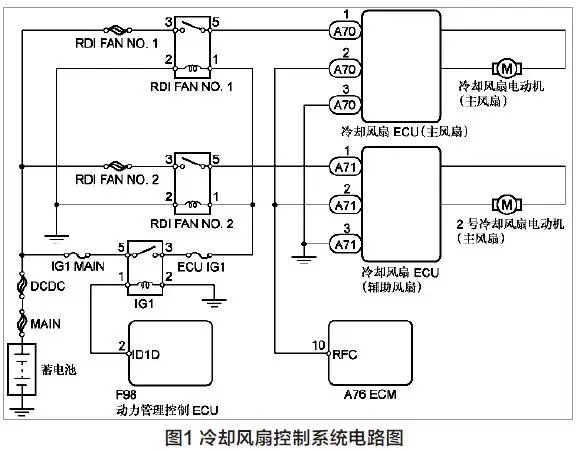
Failure phenomenon
A 2010 Lexus RX450h has a mileage of 115 986km. When the power switch is OFF, the engine cooling fan runs at high speed. When the power switch is switched to IG ON, the fan is running normally and there is no warning message ON the dashboard.
Fault diagnosis and remove
Cooling fan control system description: ECM calculates the corresponding cooling fan rotation speed according to engine cooling temperature, air conditioning switch status, refrigerant pressure, engine rotation speed and vehicle speed, and send a signal to cooling fan ECU to adjust cooling fan (Figure 1). The cooling fan ECU controls the rotation speed of each cooling fan according to the duty cycle signal from ECM.

Cause: RDI FAN NO.1 and RDI FAN NO.2 relays or their control lines are abnormal, and the relays are always closed.
Fault verification: 1. Turn off the power switch, disconnect the RDI FAN No. 1 and RDI FAN No. 2 relays, and measure the voltage between 1# and 2# on the connector side respectively. The voltage between power switch IG ON and 1#-2# is 12.5V, which proves that the relay control circuit is normal. 2. Measure the resistance values between RDI FAN NO.1 and RDI FAN NO.2 relay 3#-5# respectively. The resistance values are all less than 1Ω, which proves that the relay works abnormally and the relay contacts are short-circuited. Decompose the two relays and find that the relay contacts have been sintered together.
Replace the RDI FAN NO.1 and RDI FAN NO.2 relays for testing and troubleshooting.
Maintenance summary
1. Under normal circumstances, the probability of relay sintering together is very small, and the probability of two simultaneous sintering is smaller. This car is a lightning accident car, and the vehicle was shocked by high voltage electricity. There are 14 ECU internal short circuit (+ B and ground short circuit) on the car. Relay contact sintering reason: high voltage is applied to the 3# terminal, while the 5# terminal is grounded through the fan ECU, then under the action of high voltage, Sparks will be generated between the two contacts, because the voltage is too high, the heat generated is large, so the contacts are sintered.
2. Why does the power switch IG ON fan control normally while IG OFF fan often rotate? The fan control ECU receives ECM instructions (RFC) to control the fan speed and controls it in the form of duty cycle. When the power supply supplies power to the fan control ECU, the fan control ECU outputs a voltage of 12.5V to the ECM(RFC). According to the cooling requirements, the ECM controls the RFC to be grounded internally, and the length of grounding time constitutes the duty cycle signal. When ECM controls RFC ungrounded, RFC voltage is 12.5V, duty cycle is 100%, and fan runs at high speed. When the RCF is completely grounded, the RFC voltage is 0, the duty cycle is 0%, and the fan is not running. When the power switch IG is ON, ECM works, and RFC grounding duty cycle can be controlled normally, and fan speed can be controlled normally. When the power switch IG is OFF, the ECM stops working and the RFC signal opens between ground and ground. At this time, the RFC duty cycle is 100%, so the fan runs at high speed.
3. At present, many actuators on Lexus models use duty cycle signals to control, such as water pump, cooling fan, ignition coil IGF, blower, etc. Only knowing the control mode of duty cycle signal can suit the remedy to the case, such as who sends the voltage, how much the voltage is, and who controls the grounding, so as to correctly distinguish whether it is an actuator fault or an ECU fault. At present, in addition to the IGF voltage of the Lexus model, it is output by ECU and the igniter is grounded. The rest is basically sent by actuator and controlled by ECM.

The abnormal rotation of the fan encountered by the car is a very special fault. From the control logic, if the ignition switch is turned off, the power management control ECU has stopped supplying power to the IG1 main relay, which is equivalent to disconnecting the supply of the circuit, theoretically, there will be no power supply to cooling fan ECU through two fan relays, and the fan motor will not work. However, the failure of this car does not belong to the normal category. The reason is that the car has been struck by lightning, resulting in damage to more electrical devices, including two fan relays, and the result of electric shock is that the relay contacts are ablated and bonded, this makes the fan relay continue to supply power to the fan ECU after turning off the ignition switch. However, Toyota cooling fan control ECU happens to adopt duty cycle control. Its characteristics are similar to that of normally closed relay. When no ECM control command is issued, it meets the condition of duty cycle of 100%, this causes the fan motor to always have power supply when the ignition switch is turned off, making the motor rotate normally. It is indeed a very rare and strange fault.
The author has a relatively understanding of the circuit control mode of the car, and after careful inspection, finally determines the fault point, and makes a detailed analysis of the causes of the fault. From these two aspects, we can see that the author's rigorous working attitude is worth learning. Finally, I hope the author can write more wonderful first-line practice cases in the future so that readers can share them.